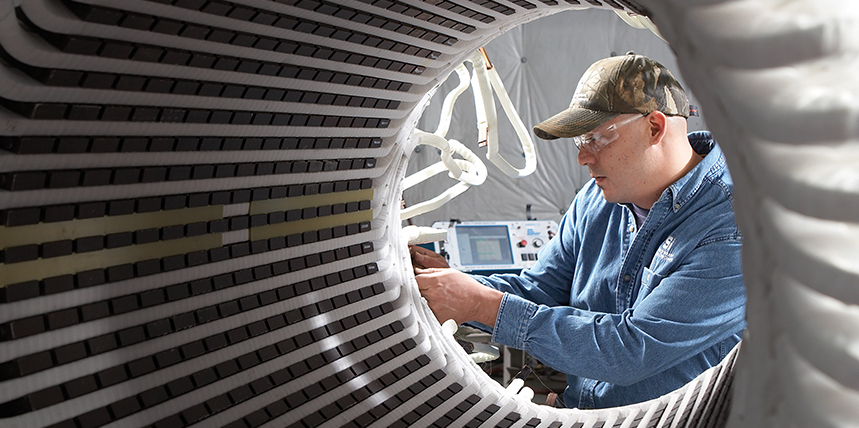How hot is too hot? Motors and transformers have maximum operating conditions, but can I exceed those ratings on occasion and not damage the equipment?
In my years as an electrical insulation application consultant, the most common questions posed by end users regard insulation thermal classes and what effect they have on machinery reliability and life expectancy. Many articles have been written on this topic, but I hope to clarify how the thermal classes are chosen and what they really mean to an industrial maintenance team, especially when choosing among various systems offered in the aftermarket.
THERMAL CLASSES
Early electrical machines were all constructed with copper windings insulated using available materials from natural sources: paper, cotton fibers and cloth, asphalt, lacquer, organic varnishes, etc. These are not normally acceptable for modern industrial machines even though they are still in limited use for some consumer products. One exception is power transmission transformers that utilize liquid insulation designs. Paper insulation is still the leading material, and that deserves its own discussion at another time.
Current dry-type transformers, such as those for motor and generator systems, typically use thermoset and thermoplastic components and might utilize copper or aluminum windings with a wide range of primary conductor insulation. These systems are developed and tested using the same methodologies used for motors and generators. The choice of insulation thermal class as well as the other properties of the materials utilized is dependent on the machine operating thermal class as designed as well as the actual end-use application.
Electric machine thermal rise is determined by electrical losses during operation and the efficiency of thermal transfer away from the conductors including other cooling systems such as fans, heat exchangers, and liquid cooling jackets. All of these must be functioning as designed or the insulation might be damaged. The National Electric Manufacturers Association (NEMA) and the International Electrotechnical Commission (IEC) have very similar definitions regarding the operating classes of motor and transformer insulation systems. These are often referred to by letter classifications. The most common are 130°C (B), 155°C (F), 180°C (H), and 220°C (C).
These operating classes are based on the hottest part of the windings (often in the center of the slot section for motors) added to the acceptable maximum ambient temperature and atmospheric pressure along with a factor (normally 10°C) for hotspot variations. For easy comparison, the maximum ambient is normally accepted as 40°C at 3,300 feet above sea level, although there are many specialty designs outside of this range. This calculation might also be affected by any service factor or duty type included in the machine design. The hottest spot during proper operation determines the thermal class of the insulation required.
It is very common in larger machines to design the temperature rise at one thermal class lower than the insulation, i.e., a 130°C rise/ambient design with a 155°C class insulation system. This is done to maintain a level of extra thermal performance to cover manufacturing variances or some intermittent overload conditions. However, in special cases such as small generators designed for intermittent use, they are designed to operate well above the normal insulation thermal design to improve output to size ratio, while still offering a reasonable life for short-term operating conditions.
Insulation degrades in several ways, and the primary concern in choosing the proper family of insulation materials is the voltage rating of the machine. At 6 kV and below, most insulation failures are due to short-term electrical stress, mechanical failure of the supporting components, or general degradation from embrittlement and weight loss over time due to heat. Above 6 kV, a key factor in insulation system failure is the presence of partial discharge (corona). PD can cause erosion or oxidation of organic materials such as resins, so the use of corona management systems and inorganic insulation such as mica-based tapes is critical to reliability. Most systems above 1 kV utilize mica anyway due to its excellent electrical and mechanical properties, but the design of the coil package and the quality of processing is also essential at higher voltages. It is also important to remember that systems testing of insulation materials only establishes the theoretical thermal class, not necessarily appropriateness for the application.
Typically, only conductors and resins officially have their own thermal ratings. Other materials — flexible insulation, tapes, supporting materials, lead wires, etc. — are all tested together with the appropriate conductor type and resin as a system. The thermal rating of that system is based on a multifactor evaluation typically at three progressively higher temperatures above the expected rating.
For low-voltage applications that are typically random-wound with flexible ground and phase insulation, IEEE Std. 117, Test Procedure for Thermal Evaluation of Systems of Insulating Materials for Random-Wound AC Electric Machinery is the testing protocol. IEEE Std.1776,IEEE Recommended Practice for Thermal Evaluation of Unsealed or Sealed Insulation Systems for AC Electric Machinery Employing Form-Wound Pre-Insulated Stator Coils for Machines Rated 15 000 V and Below, is used for higher-voltage designs where pre-insulated form-wound coils are the most common design (Figure 1).

The expectation outside of the United States is often that each component is rated at or above the system rating, but that can lead to confusion due to the various methods used to calculate thermal performance depending on the type of material. For low-voltage systems (<1 kV) that require UL ratings, there are methods to modify the set of materials utilized in additional single-point tests. However, for higher voltages, the entire system must be fully evaluated. UL and other agencies are in place to generally assure the safe failure of the system to help insurance companies manage their liabilities. They have also helped drive the development of these consensus standards from IEEE and other organizations so there is a level playing field for all manufacturers.
Some components, such as polyimide papers or rigid laminates, might have their own thermal ratings or feature fire resistance, but they are not considered in developing systems for motors or generators. However, that information is critical in switchgear or similar applications and can be useful in dry-type transformer designs.
HOW HOT IS TOO HOT?
So back to the original question: How hot can things get before it becomes a threat to reliability? With an insulation system rated 155°C and an ambient temperature limit of 40°C, that only leaves 115°C to play with. With the normal allowance of 10°C as a hot-spot allowance, that means the designed thermal rise of the machine is only 105°C at the hottest point (Figure 2).

However, operating at that range, testing shows a minimum life expectancy of only 20,000 hours. Sounds impressive, but that only works out to a little over two years of continuous duty. That might be fine for an intermittent device such as a power tool, but for an industrial motor or a wind turbine generator, that is really not good enough. So most designs use one class lower for their machine design criteria. In the case above, the thermal rise is limited to 80°C.
All this brings up the rule of thumb that the life of the machine can be doubled if operated at 10°C below the rated thermal class or cut in half if operated at 10°C above the design rating. That is possibly true for the thermal life of the insulating system, but other factors, such as thermal growth, bearing lubrication heat performance, and VFD drive influences might have greater impact on the reliability than insulation system failures. In the case of wind generators and other intermittent applications, thermal cycling conditions are much more detrimental to reliability than the maximum temperature experienced in normal operation.
Even if the thermal class of the system is 180°C and the electrical properties are excellent, the mechanical properties could suffer, as many high-temperature resins are fairly brittle, which can lead to mechanical breakdown and movement of the coils or supporting materials much sooner than would be shown in the thermal models. The key performance criteria for systems are mechanical, electrical, chemical, and thermal. To perform well in all of these areas requires a lot of very expensive components that are typically impractical in commercial applications. All good insulation systems are therefore compromises between thermal endurance and the other physical properties required for the application. As an example, a shredder motor in a steel mill runs from lightly loaded to a massive overload for just a few seconds and back. The thermal shock is bad, of course, but the mechanical requirements of shredding an automobile also extract a toll. You probably wouldn’t use the same system design as you would for a gentler application.
IMPROVED INSULATION SYSTEMS
Many motor repair centers utilize thermally and mechanically upgraded insulation systems as compared to original manufacturers because they service many industries and must be prepared for almost any conditions they might encounter. As the aftermarket industry invested in higher thermal class systems and large vacuum-pressure impregnation equipment, it became popular to feature Class H as a differentiator for marketing purposes. Does this really matter? Is there an advantage? The not-so-short answer is that in some applications, such as traction motors and other compact designs, it does make a difference because those machines are mostly designed with a higher temperature rise to minimize the size of the motor.
For the typical Class F machine designed with a Class B rise, it can help to minimize premature degradation if the reprocessed core lamination is less efficient than the original, but mostly it just inspires confidence that the windings have some additional margin at the upper range of the operating temperatures. An exception, in my experience, concerns larger machines such as synchronous motors and hydro generators. The higher thermal class will make little difference, especially in voltages above 6 kV, and when dealing with partial discharges, it can be even easier to manage them with Class F pressed coils than with VPI designs. Although considered expensive for high-volume manufacturers, pre-impregnated pressed coils are extremely reliable and offer many other advantages to the repair facility as well as the end user.
Dry-type, air-cooled transformers are normally subjected to very little mechanical stress, so high thermal rise is more acceptable. Specialty supports and barrier insulation sheets as well as silicone or modified epoxy resins are the rule rather than the exception. It all comes down to cost. With cast-coil designs, Class F is the norm as those materials are relatively easy to use and are very cost-effective.
CONCLUSION
It is really up to the original designer of the equipment to specify the right type of materials for the thermal requirements as well as the mechanical stresses of the application. They most often get it right, but sometimes an aftermarket solution is an improvement over the original design because a wide range of options is available to address a known failure mode that might not be apparent to the original equipment manufacturer. Be sure and consult with a competent and experienced repair specialist, and make an informed decision on the thermal class and other properties needed to achieve optimum life expectancy for the repair.
Takeaways
- Thermal class shouldn’t be the only criterion.
- Not all high-temperature systems are right for every application.
- Be aware of de-rating requirements if operating in higher ambient temperatures.
- Carefully consider the operating conditions before specifying the motor or the repair, and share that with the provider.

Kevin Alewine is Director of Renewable Energy Services at Shermco Industries with a focus on business development in the wind-energy business sector. He has extensive global experience with the application of electrical insulation materials, systems, and processes for the manufacture and repair of electrical machinery. Kevin formerly chaired the American Clean Power Operations and Maintenance Committee developing recommended practices for wind-energy asset maintenance. Additionally, Kevin was the General Chair of the 2019 IEEE Electrical Insulation Conference and is a member of the IEEE Dielectric and Electrical Insulation Society Administrative Committee.
